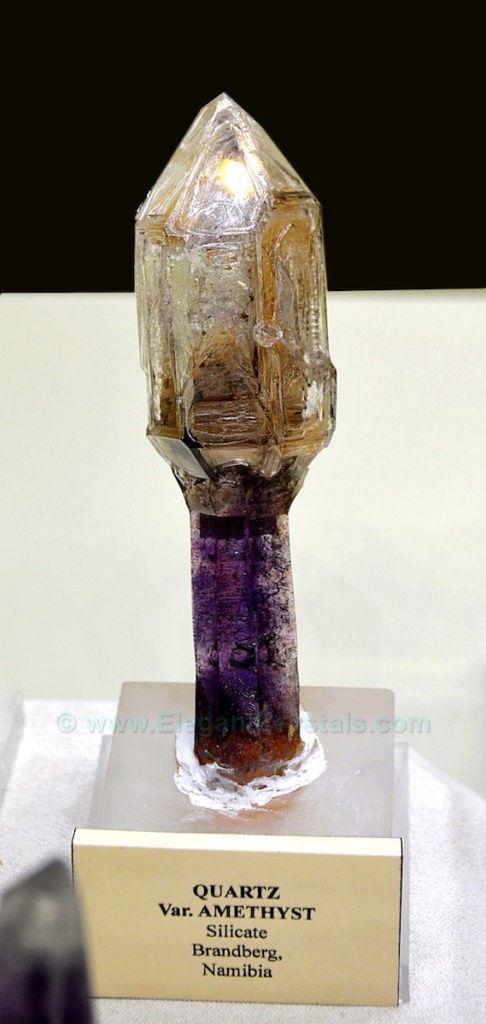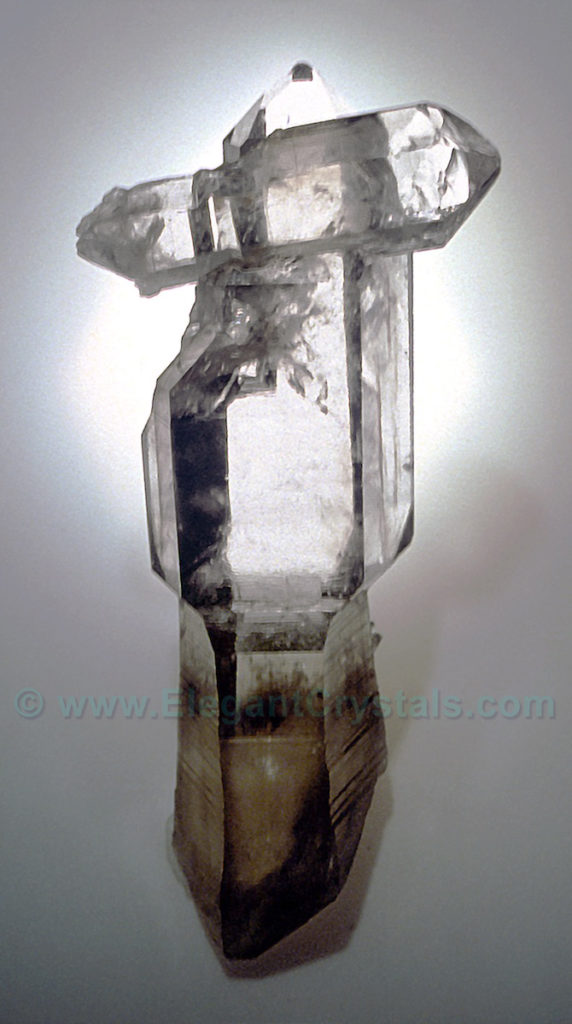CHAPTER 9
SCEPTER CRYSTALS

Picture #66
4-inch-tall African Scepter
with Clear, Citrine And Purple Quartz
We are now moving into the world of exotic crystal shapes.
The one pictured above is called a scepter crystal.
It contains amethyst, iron, clear quartz, citrine and smoky quartz.
This complicated combination of quartz colors only occurs in a few spots in the world.
Some American locations produce amethyst, smoky and/or clear quartz scepters.
Typically, they are quite small, and do not have the complicated colors and shapes of these African treasures.
Hallelujah Junction, Nevada is the exception.
There are big scepter crystals with incredible color combinations at this mine on Petersen’s Peak.
One of the things that I like best about scepter crystals, like this four-inch wonder, is the handgrip built right in.
Since I like to hold crystals for their energy and healing effects, these are perhaps the most comfortable ones to get a grip on.
If I am waving a crystal around during a healing session, or dancing with crystals, these scepters provide a superior grip.
The scepter formation, in general, consists of two separate crystals.
The bottom one electrically attracts and aligns the seed of the scepter head to electronic energy beam that runs straight up through the center of the crystal.(C-axis)
These two crystals fuse together in an act of aligned mineral attraction and energetic love.

Picture #67
Two-inch-long Interpenetrating Brazilian Scepters
This is a one-in-a-million configuration.
These Brazilian scepters grew next to each other in such a way that they intersected in space and fused at the junction.
The larger crystal grabbed onto the smaller one and supported it securely in position.
Both crystals contain smoky quartz fading into clear quartz zones.
All the edges and sides are perfectly formed.
The bottom of each scepter was joined to the matrix rock, which then broke off cleanly during mining.
While the crystals look huge in the photograph, in reality the biggest one is only two inches tall.
I have a special camera lens that allows me to control the perspective of the photograph.
In this way, I can take an extremely small object and make it look huge.
In many photographs, I try to provide a face, a hand or an object to provide scale.
This way you can instantly tell the crystal’s size in relation to something else.
However, when I think a little crystal deserves a lot of attention, I will not use an object for scale.
Rather, I will use the perspective control lens to make the stone look significantly larger.
This way, people will not discriminate against a small crystal just because of its size.

Picture #68
8-inch-tall Brazilian Twinned Black Scepter
I took this photograph in 1984 at the giant yearly gem show in Tucson, Arizona.
At that time, I barely knew what a scepter crystal was.
They are so rare that in seven years I had only seen one or two small ones.
When I met this black behemoth, I was amazed at the possibilities for the variety of crystal shapes on earth.
It was in a showcase at the Tucson Civic Center, glowing darkly with glints of reflected light.
When my camera’s flash unit fired, I got the most beautiful glittery reflections off the tip of the crystal.
These happen to show the intricate layered patterns in the quartz.
The base of this scepter is a single, opaque smoky quartz crystal covered by tiny drusy quartzes.
The little crystals create a textured surface on the scepter handle that feels quite different from the slick facets at the tip.
I have never seen another doubled scepter like this one.
The tip exhibits Dauphiné parallel twinning.
This means that the interior of the crystal has two separate electronic spirals moving in the same direction.
We will be talking more about these energy spirals in a later book on Quartz Crystal castles.
While this crystal looks completely black, I did not have a chance to put a spotlight behind it to check for any translucency or color zoning.
I think the crystal is extremely dense because it is more than three inches thick.
